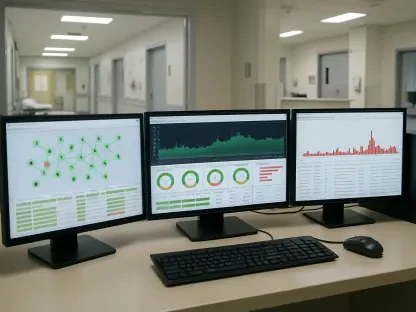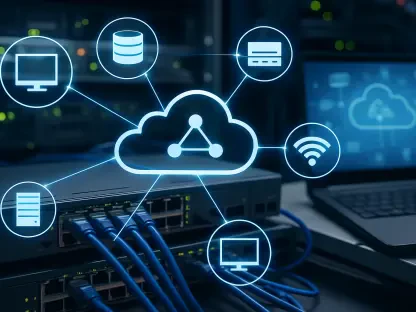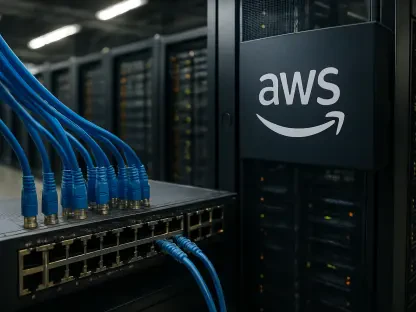In a world where every second counts, edge computing is revolutionizing healthcare by processing critical data right at the source, eliminating the delays tied to distant cloud servers, and empowering hospitals, clinics, and care providers to make split-second decisions that can save lives. This technology is particularly vital in emergencies where immediate insights are paramount. Picture a scenario in an intensive care unit where a patient’s vital signs are analyzed instantly, allowing doctors to intervene before a situation spirals out of control. As the demand for faster, more efficient medical solutions surges, edge computing stands out as a transformative force, addressing the urgent need for real-time data in an industry under constant pressure to improve outcomes. By decentralizing data processing, this innovation not only enhances responsiveness but also paves the way for smarter, more connected healthcare systems that can adapt to the evolving needs of patients and providers alike across diverse settings.
Revolutionizing Critical Care with Instant Insights
Edge computing’s ability to slash latency is proving invaluable in high-stakes medical environments where timing is everything. Unlike traditional cloud-based systems that require data to travel across vast distances for processing, this technology handles information locally, delivering results in near real-time. In surgical suites, for instance, edge computing enables instantaneous analysis of patient data, ensuring surgeons can make informed decisions without delay. Similarly, in emergency rooms, rapid access to diagnostics can mean the difference between life and death. This capability extends beyond hospital walls to telemedicine, where doctors can assess patients remotely with minimal lag, ensuring timely interventions. The profound impact of such speed on patient outcomes cannot be overstated, as it equips healthcare professionals with the tools to act decisively in the most critical moments, ultimately enhancing the quality of care provided.
Beyond emergencies, edge computing supports ongoing patient monitoring with remarkable efficiency, transforming how chronic conditions are managed. For patients with heart disease or diabetes, wearable devices generate continuous streams of health data that need immediate analysis to detect anomalies. Edge technology processes this information on the spot, alerting caregivers to potential issues before they escalate into crises. This proactive approach reduces hospital readmissions and eases the burden on medical facilities by allowing for early interventions. Moreover, in remote areas where connectivity to centralized systems may be unreliable, local data processing ensures that care remains uninterrupted. The adaptability of edge computing to various clinical scenarios underscores its potential to redefine standards of responsiveness in healthcare, making it a cornerstone for future advancements in patient management and treatment protocols.
Synergy with Modern Technologies
The integration of edge computing with cutting-edge innovations like the Internet of Things (IoT), 5G networks, and artificial intelligence (AI) is accelerating its adoption in healthcare. IoT devices, such as smart inhalers and fitness trackers, produce enormous volumes of data that can overwhelm traditional systems if sent to distant servers. Edge computing steps in by processing this information locally, reducing bandwidth strain and ensuring swift analysis. When combined with 5G’s ultra-fast, low-latency connectivity, the result is seamless communication between devices and providers, even in data-heavy applications like live video consultations. AI further amplifies this by enabling on-the-spot analytics at the edge, offering predictive insights that enhance decision-making. This powerful combination is setting a new benchmark for efficiency in medical technology, driving smarter and more responsive care delivery across the board.
A striking example of this synergy is seen in recent collaborations that push the boundaries of surgical precision through edge computing. Partnerships between major medical technology firms and AI leaders have led to breakthroughs in robotic surgery, where real-time data processing minimizes risks during complex procedures. By leveraging edge AI platforms, surgeons gain access to immediate feedback and enhanced visualization, improving accuracy and patient safety. This integration not only boosts clinical outcomes but also highlights how interconnected technologies can address longstanding challenges in healthcare. As 5G infrastructure expands globally, the potential for such innovations to scale becomes even greater, promising a future where remote surgeries and real-time diagnostics are commonplace. The convergence of these tools at the edge signals a shift toward a more agile and data-driven medical landscape, poised to meet the demands of an increasingly digital world.
Tailored Solutions Across Healthcare Settings
Edge computing offers a versatile array of components, including hardware, software, and managed platforms, designed to meet the unique needs of diverse healthcare environments. In busy urban hospitals, for instance, edge solutions ensure that critical systems like electronic health records are accessible without delay, streamlining workflows and reducing wait times for patients. Meanwhile, in smaller clinics or ambulatory care centers, these technologies enable efficient data handling despite limited resources, ensuring that even underserved areas benefit from modern care standards. The flexibility of edge computing allows it to address both clinical needs, such as real-time diagnostics, and operational challenges, like managing patient flow. This adaptability makes it an essential tool for modernizing healthcare infrastructure, ensuring that facilities of all sizes can deliver high-quality services tailored to their specific circumstances.
The impact of edge computing extends to long-term care facilities and home care settings, where continuous monitoring is often a lifeline for vulnerable populations. Elderly patients or those with chronic illnesses rely on devices that track vital signs, and edge technology processes this data locally to provide instant alerts to caregivers if something goes wrong. This immediacy not only enhances safety but also offers peace of mind to families, knowing that help is just moments away if needed. Additionally, by reducing the dependency on centralized cloud systems, edge solutions ensure that care remains consistent even in areas with spotty internet access. This broad applicability across different end-users—from sprawling medical campuses to individual households—demonstrates the transformative potential of edge computing to create a more inclusive and responsive healthcare ecosystem, addressing disparities in access and quality of care on a global scale.
Explosive Market Growth and Regional Dynamics
The market for edge computing in healthcare is experiencing remarkable expansion, with projections estimating a compound annual growth rate of 28.5% through 2034. This surge is fueled by the growing reliance on digital health solutions, the increasing prevalence of chronic conditions requiring constant oversight, and the widespread shift toward telemedicine, a trend that gained significant momentum during the global health crisis. North America stands at the forefront of this growth, thanks to its advanced technological infrastructure and substantial investments in innovation. The region’s dominance is further supported by a robust ecosystem of tech companies and favorable policies that encourage the adoption of cutting-edge tools. As healthcare systems worldwide prioritize efficiency and connectivity, edge computing is becoming a linchpin in meeting these evolving demands, with significant implications for patient care and system scalability.
While North America leads, other regions are rapidly catching up as digital transformation reshapes global healthcare landscapes. The Asia-Pacific region, encompassing countries like China, Japan, and India, is emerging as a high-growth area due to rising populations, expanding access to technology, and government-led initiatives to modernize medical services. Europe, with its strong focus on digital health policies in nations like Germany and the UK, is also seeing steady adoption of edge solutions to enhance care delivery. Meanwhile, areas like Latin America and the Middle East & Africa, though currently behind in implementation, show immense potential as infrastructure improves and awareness of edge computing’s benefits grows. This global momentum reflects a shared recognition of the technology’s capacity to address critical gaps in healthcare delivery, setting the stage for widespread advancements over the coming years.
Key Drivers Fueling Rapid Adoption
At the heart of edge computing’s rise in healthcare is the pressing need for immediacy in data access, particularly in life-or-death situations. Medical professionals in emergency departments and intensive care units rely on instant insights to make decisions that can save lives, and edge technology delivers by processing information right where it’s generated. This local approach eliminates the bottlenecks associated with sending data to remote servers, ensuring that patient care isn’t compromised by technical delays. The result is a significant boost in operational efficiency, allowing hospitals to handle high-pressure scenarios with greater confidence. As healthcare systems face mounting demands to improve response times and outcomes, the ability of edge computing to provide real-time solutions is a driving force behind its growing integration into clinical workflows.
Another major catalyst for adoption is the explosion of IoT devices in medical settings, which generate vast amounts of data requiring immediate attention. From smart monitors in hospitals to wearable trackers on patients, these tools are essential for continuous health surveillance, but they can overwhelm centralized systems if not managed locally. Edge computing steps in to process this deluge of information without straining network resources, ensuring that critical alerts are delivered promptly. This capability is especially vital as the prevalence of chronic diseases rises, necessitating ongoing monitoring for millions of patients worldwide. By enabling healthcare providers to keep pace with the data demands of modern medicine, edge solutions are helping to build a more resilient and adaptive infrastructure, capable of supporting both current needs and future growth in digital health applications.
Addressing Security and Regulatory Hurdles
Despite its many advantages, edge computing in healthcare must navigate significant challenges, with data security emerging as a primary concern. Processing sensitive patient information at local points increases the risk of cyberattacks and breaches, which could have devastating consequences for both providers and individuals. The distributed nature of edge systems, while efficient, creates multiple entry points for potential threats, making robust protection measures a top priority. Healthcare organizations must invest in advanced encryption and secure data transfer protocols to safeguard information and maintain trust. As cyber risks continue to evolve, addressing these vulnerabilities remains a critical barrier to the widespread acceptance of edge technology, requiring ongoing vigilance and innovation to stay ahead of potential dangers in an increasingly connected medical landscape.
Compliance with stringent regulations adds another layer of complexity to the adoption of edge computing in healthcare. In the United States, laws like the Health Insurance Portability and Accountability Act (HIPAA) set strict standards for handling patient data, demanding that organizations ensure privacy and security at every step. Similar regulations exist globally, each with unique requirements that must be met to avoid legal and financial repercussions. For edge solutions, this means implementing safeguards that protect information even when processed outside traditional centralized systems. Balancing the need for speed with these regulatory demands is a delicate task, but one that is essential for building confidence in the technology. Overcoming these hurdles through strategic planning and investment in compliance frameworks will be key to unlocking the full potential of edge computing in transforming healthcare delivery.
Shaping a Connected Future for Medicine
Looking back, edge computing has carved a pivotal path in healthcare by tackling latency issues that once hindered timely care, reflecting on how it empowered providers with immediate data during critical moments. Its integration with IoT, 5G, and AI marked a turning point, enhancing everything from robotic surgeries to remote monitoring with unprecedented precision. As the market expanded at a remarkable pace, regions like North America set benchmarks for innovation, while others began bridging gaps in access and infrastructure. Moving forward, the focus must shift to fortifying security measures and navigating regulatory landscapes to sustain this momentum. Stakeholders should prioritize collaborative efforts to develop standardized protocols that protect data at the edge, ensuring trust and scalability. By investing in these solutions now, the healthcare industry can build on past achievements to create a more connected, responsive future, where real-time insights continue to redefine patient care on a global scale.









